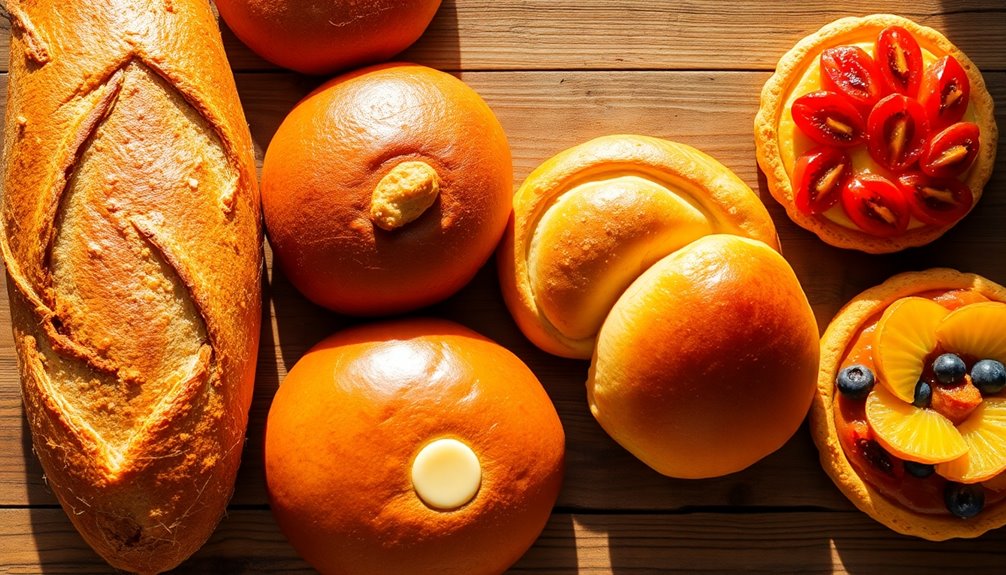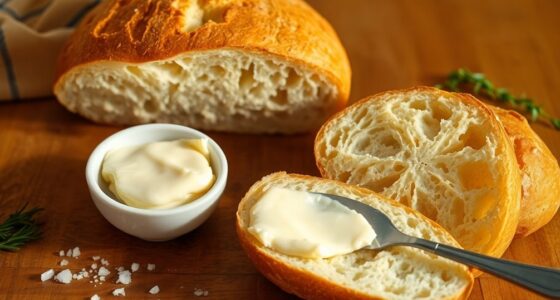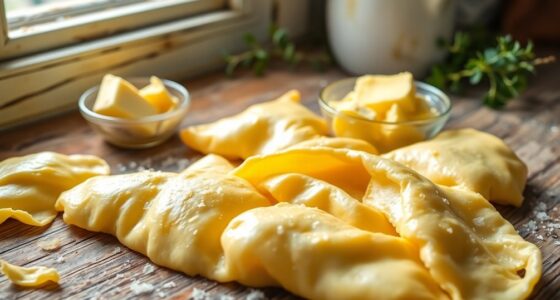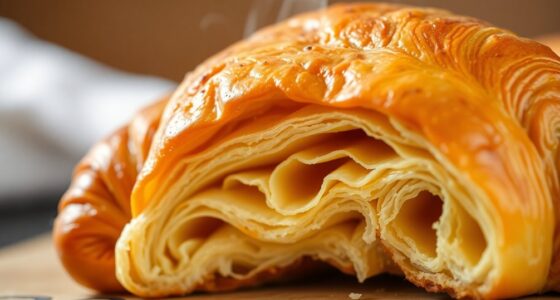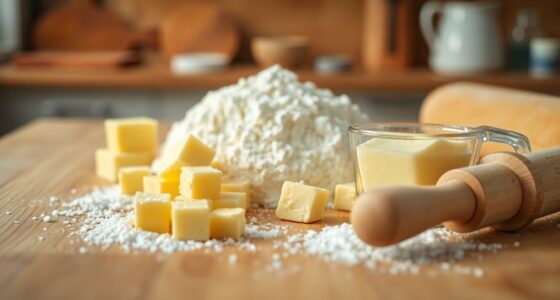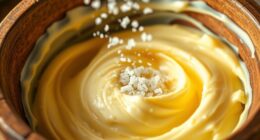Butter's a key player in global baking, enhancing textures and flavors in everything from flaky Danish pastries to rich Italian brioche. You'll find it brings life to French croissants and adds depth to German desserts like Black Forest cake. Middle Eastern treats and Asian delights also showcase butter's versatility, creating indulgent sweets. Discover how different cultures celebrate through these delightful baked goods and the unique stories behind them. You won't want to miss what's next!
Key Takeaways
- Butter is essential in creating flaky textures and rich flavors across various global pastry traditions, enhancing both taste and nutritional value.
- Danish pastries exemplify the use of high-quality butter, creating delightful layers and fostering social connections through shared enjoyment.
- French techniques like lamination utilize butter to achieve exquisite layers, while beurre noisette adds a nutty depth to desserts.
- German pastries, such as Black Forest cake and stollen, highlight the importance of butter in achieving rich flavors and flaky textures.
- Italian classics like brioche and cannoli showcase butter's role in creating moistness and delicate textures, contributing to their culinary heritage.
The Role of Butter in Global Baking Traditions
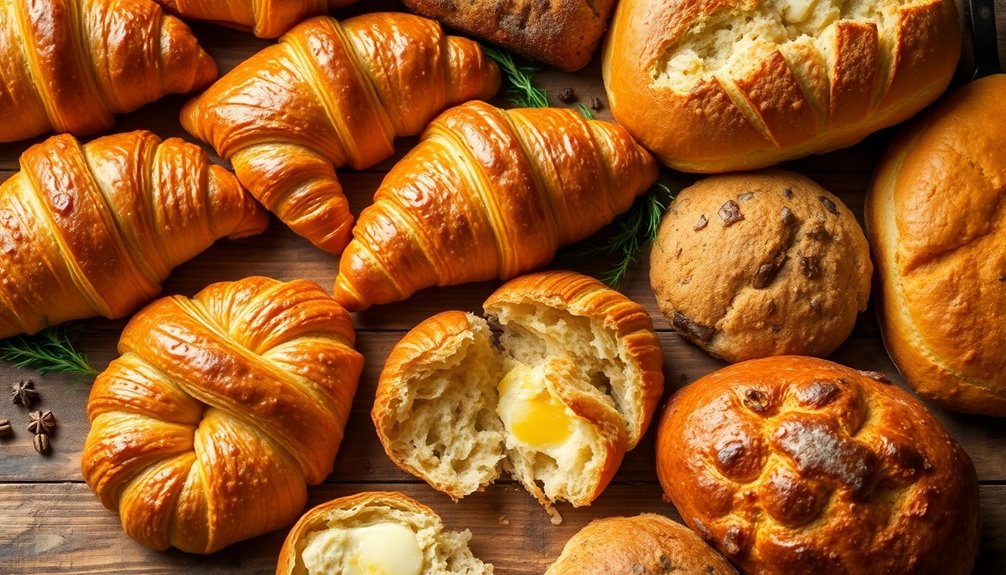
When you explore global baking traditions, you'll quickly notice that butter plays a vital role in creating the textures and flavors we love.
This rich history of butter in baking crosses cultural boundaries, enhancing everything from Italian panettone to German bee sting cake. Its creamy richness transforms dough into flaky, buttery pastry, elevating sweet treats like French éclairs and tarts.
You'll find that local ingredients often blend seamlessly with butter, crafting unique flavors and textures that define each region's specialties.
Whether it's a celebratory Victoria sponge in the UK or a classic Danish pastry, butter's influence is undeniable. It's not just an ingredient; it's a key player in the art of baking that creates cherished moments and delightful experiences. Additionally, the nutritional information reveals that butter is a source of vitamins A, E, and K2, contributing to its importance in culinary traditions.
Flaky Layers: The Art of Danish Pastries
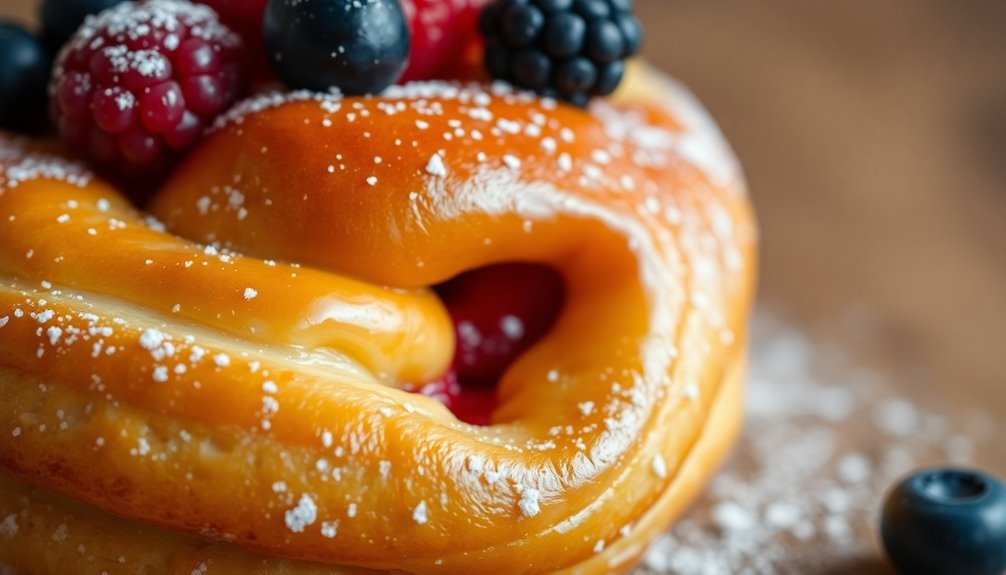
Danish pastries, or "Wienerbrød," are a delightful treat that showcases the artistry of flaky layers and rich flavors.
Originating from Austrian techniques, these pastries rely on high-quality butter to create their signature buttery texture. The balance of sugar and butter is essential, allowing spices like cinnamon and fillings such as pastry cream and almonds to shine.
You'll love how modern bakers adapt traditional Danish recipes, offering gluten-free options that maintain the delightful experience.
Enjoying these pastries in social settings fosters connections and evokes nostalgia, making them a staple in Danish culture.
Artisan bakeries continue to innovate while honoring their heritage, ensuring that every bite remains a celebration of flaky perfection.
French Pastries: Elevating Techniques With Butter

When you think of French pastries, the role of butter is hard to overlook. Its rich flavor not only enhances the taste but also brings that perfect flaky texture to classics like croissants and éclairs. Additionally, regular skin treatments can be beneficial for maintaining a radiant look that complements the indulgence of enjoying these pastries.
Classic French Techniques
While mastering classic French pastry techniques may seem intimidating, understanding the vital role of butter can simplify the process considerably.
French pastries are celebrated for their flaky textures, and the use of high-quality butter is essential in achieving this. Techniques like lamination, found in croissants and éclairs, require precise folding of butter into dough, creating those delightful layers.
When making pâte feuilletée, or puff pastry, you'll fold butter multiple times to achieve the delicate structure needed for pastries like mille-feuille and palmiers.
Paying attention to the incorporation of butter at specific temperatures is important, as it directly affects the rise and texture of your classic pastries. Butter's smoke point also plays a crucial role in determining the ideal cooking methods for various pastry recipes.
With practice, you'll master these techniques and elevate your creations.
Butter's Flavor Elevation
Butter's unique ability to elevate flavors in French pastries is a game changer. Its rich flavor and flaky texture create pastries that are simply irresistible. Techniques like lamination guarantee that cold butter is perfectly layered, resulting in airy, delicate croissants. The art of beurre noisette adds a nutty depth to desserts, enhancing treats like madeleines and financiers. Additionally, the creamy texture of butter is influenced by the emulsification process during churning, which contributes to the overall quality of the pastries.
Here's a quick look at how butter transforms these pastries:
| Technique | Effect on Pastry |
|---|---|
| Lamination | Creates flaky layers |
| Beurre Noisette | Adds nutty flavor |
| Beurre Manié | Thickens & enhances flavor |
With butter's flavor elevation, you can truly appreciate the complexity of international desserts and the mastery behind each bite.
Rich and Decadent German Treats
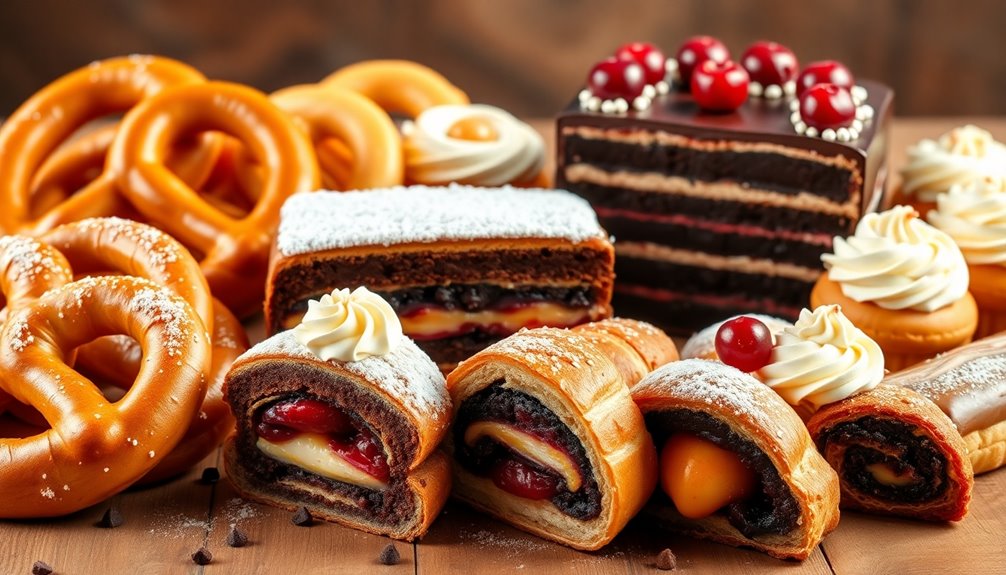
German treats are a delightful indulgence, offering a rich tapestry of flavors and textures that captivate the senses.
You'll find German pastries like Black Forest cake, which combines chocolate sponge, cherries, and whipped cream for a luscious experience.
Then there's bee sting cake, a sweet yeast dough filled with cream and topped with caramelized almonds, perfect for a special occasion.
Don't forget apple strudel, with its thin layers of dough packed with spiced apples and cinnamon, showcasing traditional baking techniques.
During the holidays, enjoy stollen, a fruit bread filled with dried fruits and marzipan.
These sweet treats reflect Germany's baking traditions, emphasizing high-quality local ingredients, especially butter, which enhances the rich flavors and flaky textures.
Italian Classics: Butter's Influence on Flavor
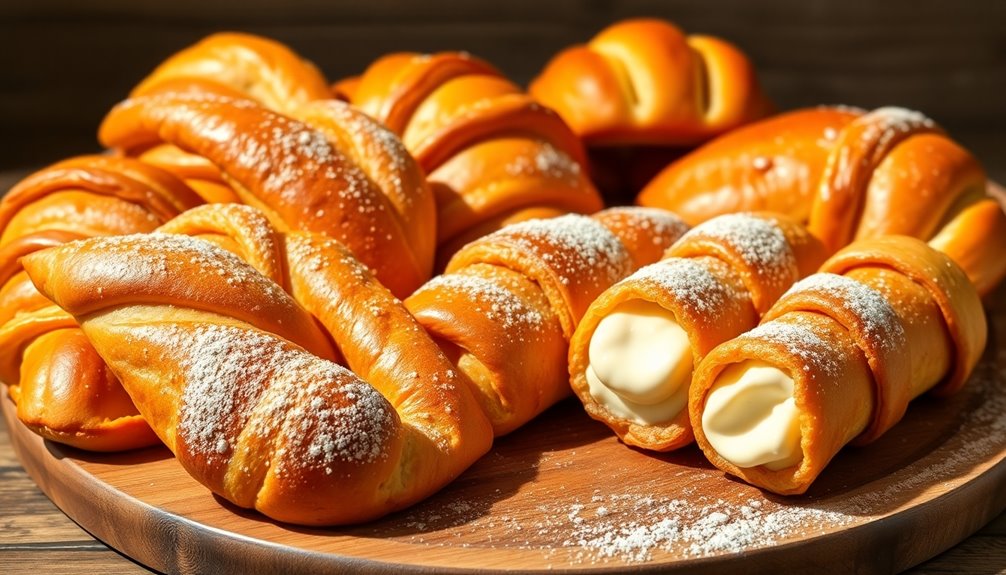
When you think of Italian pastries, butter's role in creating rich textures and flavors can't be overlooked.
From the flaky layers of cornetti to the creamy indulgence of tiramisu, traditional techniques showcase how butter enhances each bite.
As you explore these classics, you'll appreciate the perfect balance that butter brings to every recipe.
Rich Textures and Flavors
While exploring Italian classics, you'll quickly discover how essential butter is to their rich textures and flavors.
In pastries like brioche and panettone, butter enhances their richness, contributing to the characteristic flaky textures you adore.
Traditional Italian pastries, such as sfogliatelle, rely on layers of butter to create a distinctively crispy and airy structure, crucial for that signature shape.
Italian butter-based cakes, like torta della nonna, owe their moist and tender crumb to high-quality butter in the batter.
Even in cannoli shells, butter adds flavor while ensuring a delicate, crisp texture that beautifully complements the sweet ricotta filling.
The balance of butter with other ingredients is indispensable, helping artisanal bakers craft delicious Italian pastries you can't resist. Additionally, the use of high-quality butter ensures optimal flavor and texture, making it a vital component in traditional recipes.
Traditional Techniques and Applications
Italian baking techniques showcase how butter's influence extends beyond flavor to the very methods used in crafting beloved pastries.
High-quality butter is essential in creating rich flavors and flaky textures, especially in these classics:
- Brioche – Infused with buttery layers, it's a staple breakfast delight.
- Cornetti – These croissant-like pastries achieve their flakiness through careful lamination, enhancing the buttery experience.
- Torta della Nonna – Combining butter with lard, this dessert showcases flavor complexity in its inviting crust.
Additionally, the use of grass-fed butter enhances the nutritional profile of these baked goods, making them even more appealing.
Sweet and Savory Pastries From the Middle East

Middle Eastern pastries are a delightful blend of sweet and savory, enchanting taste buds with their rich flavors and intricate layers.
You'll find treats like baklava, which layers nuts and honey in a complex texture that dates back to the 8th century B.C. Borma, another favorite, rolls dough around nuts, often infused with rosewater or orange blossom for a unique flavor.
Savory pastries, such as spinach pies and cheese-filled delights, showcase organic ingredients and spices that reflect the region's diverse culinary heritage.
These traditional pastries aren't just desserts; they're integral to festivals and celebrations.
As their popularity spreads globally, you can enjoy variations like Turkish baklava and Arabic kunafa, each offering its own twist on these classic Middle Eastern recipes.
Asian Delights: Butter in Unique Desserts
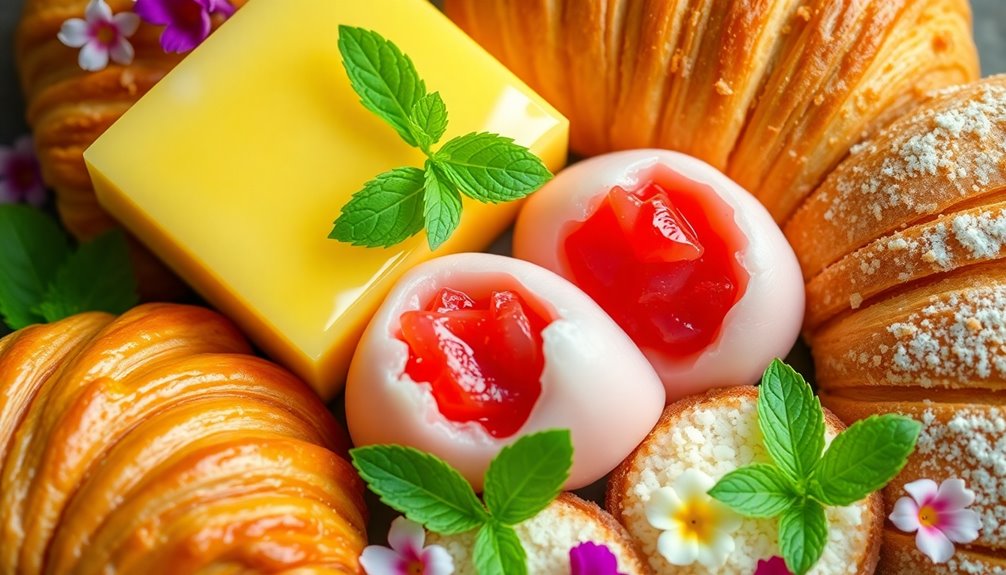
When you explore Asian desserts, you'll discover how butter transforms traditional recipes into indulgent treats.
These sweet delights showcase the rich flavors and textures that butter brings to the table:
- Japanese castella: This fluffy sponge cake combines butter with flour, sugar, and egg yolks, creating a moist, melt-in-your-mouth experience.
- Leche flan: In the Philippines, this creamy custard blends egg yolks, condensed milk, and butter, resulting in a luscious dessert topped with caramel.
- Khanom chan: A Thai dessert, this multi-layered cake uses coconut milk and butter for a soft consistency, harmonizing sweet and savory flavors.
Each of these desserts highlights how butter elevates simple ingredients into unforgettable sweet treats. Additionally, the health benefits of curcumin's anti-inflammatory properties found in turmeric can enhance your overall enjoyment of these delightful desserts.
Indulging in these delights is a must for any dessert lover!
The Fusion of Global Flavors and Techniques
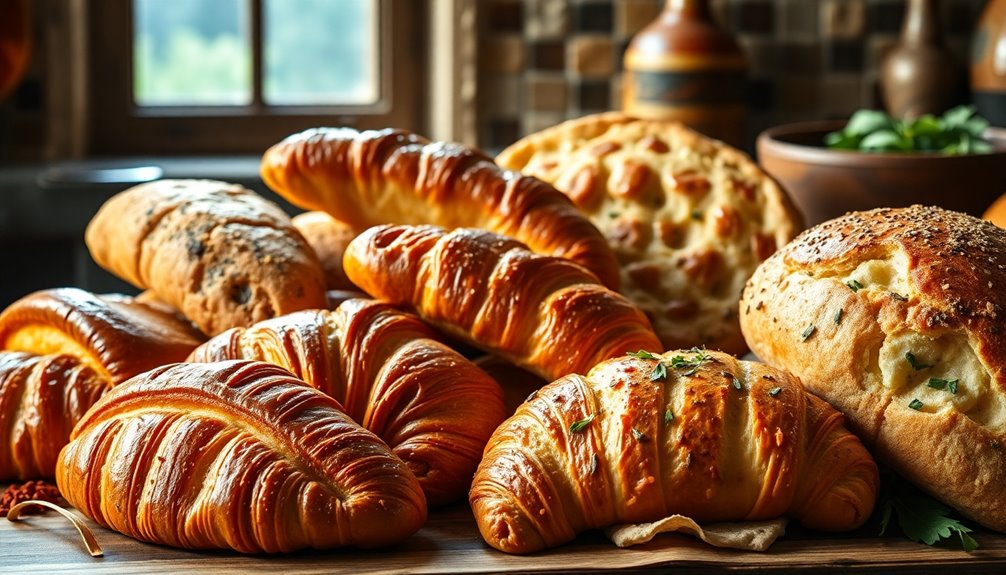
As global travel and communication have expanded, bakers have seamlessly blended flavors and techniques from around the world, creating exciting desserts that captivate the palate.
This fusion of global flavors results in innovative creations like matcha-infused American brownies or Tres Leches cake enhanced with Japanese matcha. By incorporating local ingredients with traditional recipes, you're crafting unique fusion desserts that cater to adventurous eaters.
Modern baking techniques and the accessibility of international ingredients encourage you to experiment and push culinary boundaries. As you explore these creative combinations, you celebrate cultural diversity while maintaining a commitment to quality and craftsmanship.
Marketing these fusion pastries through storytelling highlights the rich cultural significance behind each treat, fostering deeper appreciation among consumers.
Celebrating Community Through International Baking
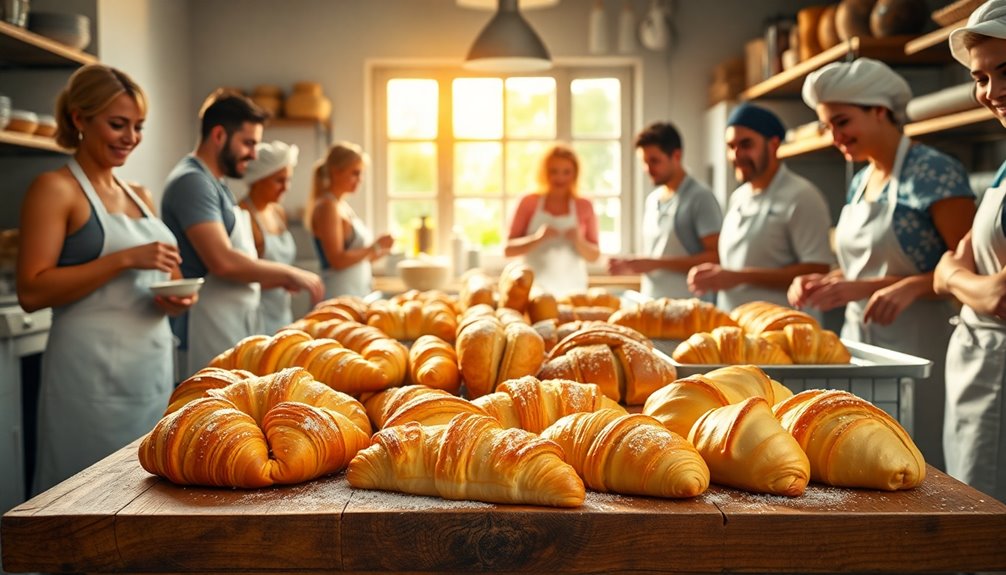
Bakeries around the world play a pivotal role in fostering community, creating spaces where people gather to enjoy the simple pleasure of freshly baked goods.
These sweet treats not only satisfy cravings but also connect diverse cultures. Envision this:
- Danish pastries, flaky and rich, enjoyed in cozy cafés, sparking laughter and conversation.
- French croissants, warm and buttery, shared over morning coffee, igniting new friendships.
- Middle Eastern baklava, sweet and sticky, bringing families together during festive celebrations.
These baked goods celebrate traditions from around the globe while introducing new flavors that unite us.
During challenging times, bakeries have become comforting hubs, reminding us of the emotional support and connections we find in our community through the joy of baking.
Frequently Asked Questions
What Is the Most Popular Pastry in the World?
When you think about the most popular pastry in the world, the croissant often comes to mind. Its flaky layers and buttery flavor make it a favorite for many. You might enjoy it fresh from the oven, paired with a cup of coffee.
However, don't overlook other contenders like Danish pastries or Pastel de Nata, which also hold a special place in people's hearts. Each pastry brings its unique charm to the table.
What Is the Main Purpose of Butter in Pies and Pastries?
Imagine biting into a perfectly flaky pastry. What makes it so irresistible? That's where butter comes in.
Its primary purpose in pies and pastries is to create that desired flaky texture. By incorporating cold butter, you're allowing steam to form during baking, which lifts the layers.
Plus, it adds richness, flavor, and tenderness, preventing your dough from becoming tough. Butter also acts as a moisture barrier, keeping your crust intact and delicious.
What Is the Pastry Capital of the World?
If you're looking for the pastry capital of the world, Paris is the clear answer.
This vibrant city boasts an impressive array of patisseries known for their exquisite creations like croissants and éclairs. You'll find renowned names like Pierre Hermé and Ladurée, each offering a taste of French baking artistry.
Plus, the lively café culture here guarantees that pastries are more than just treats; they're a daily ritual for locals and visitors alike.
Why Are Pastries so Popular in Denmark?
Pastries are incredibly popular in Denmark because they embody a rich cultural tradition that blends buttery richness with a hint of sweetness.
You'll find that these treats are integral to social gatherings, creating moments of connection among friends and family. Their flaky texture and delightful flavors appeal to a wide audience.
Plus, the rise of innovative baking keeps traditional pastries fresh and exciting, ensuring they remain a comforting staple in Danish life.
Conclusion
Just like a well-kneaded dough, our culinary world is enriched by diverse influences. Butter, the golden thread weaving through each tradition, binds us together in a tapestry of flavors. As you explore these global pastries, think of them as stories waiting to be shared, each bite a page turning in the book of culture. So, grab your rolling pin and commence on this delicious journey, where every pastry is a bridge connecting hearts across continents.
